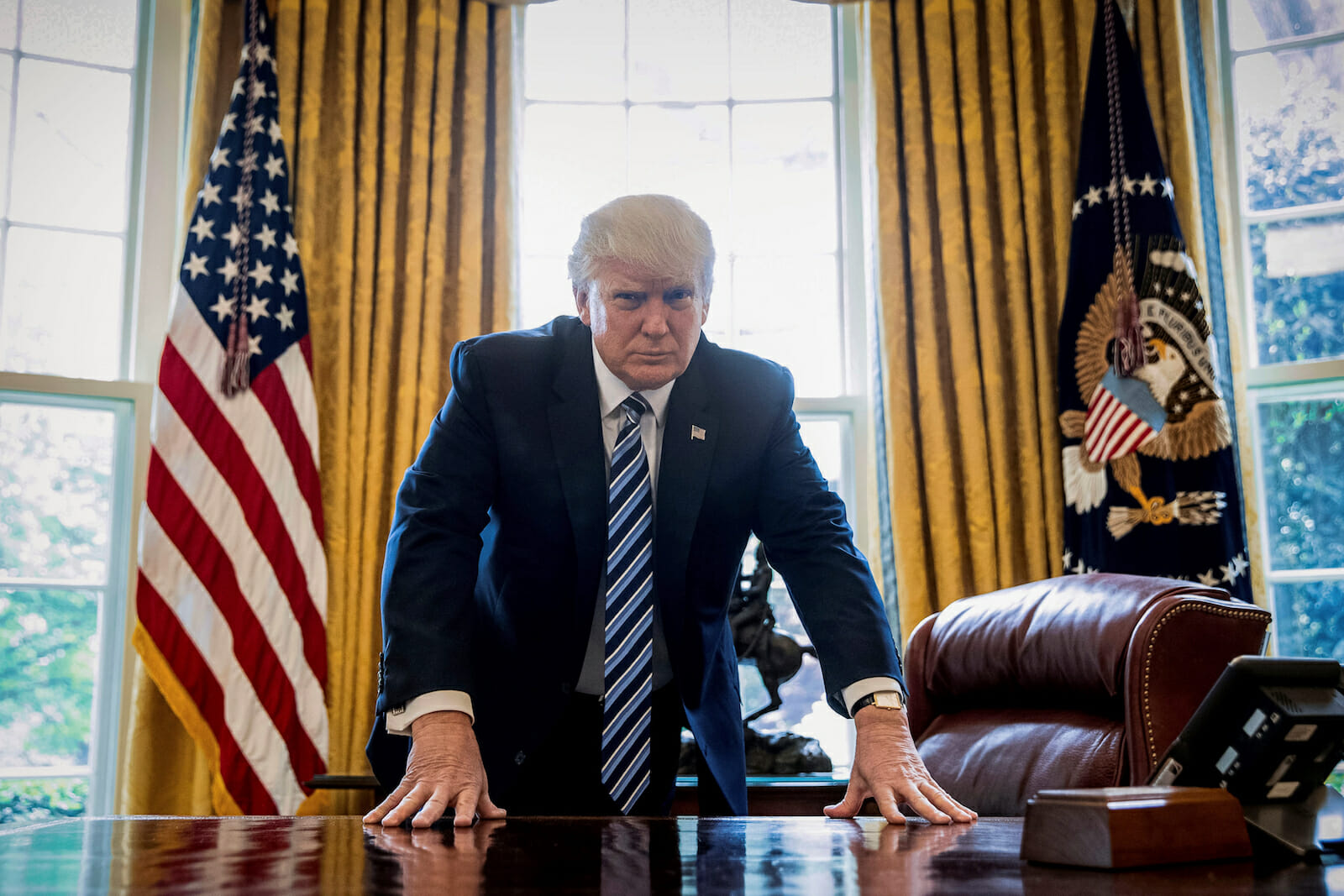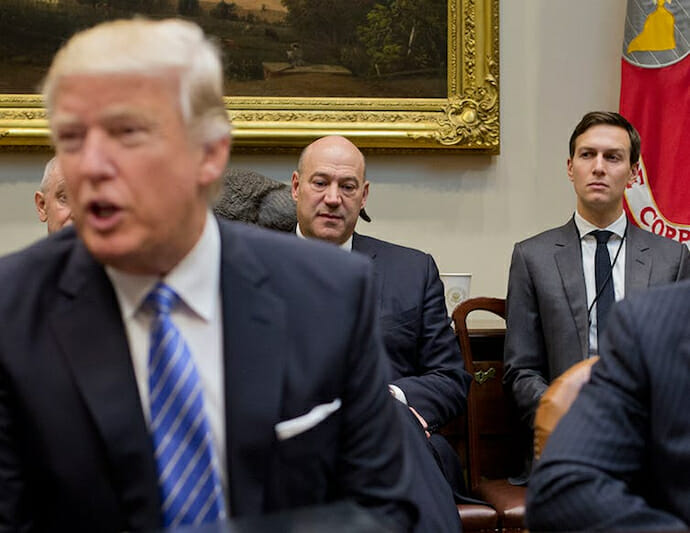
Politics
Trump’s Brand of Economic Populism Gets a Makeover in First 100 Days
How can we make sense of the economic policy roller-coaster ride of Donald Trump’s first 100 days as president?
Trump’s statements soon after taking office made many hope (or fear) that a new form of populism had become the guiding ideology of the White House. But a dizzying series of reversals in recent weeks has led others to conclude that the new administration’s economic approach will be Republican “business as usual.”
Has Donald Trump really changed his tune on the economy since the inauguration? Have his policies served the interests of his working-class base, or are they friendlier to his friends in the corporate world? And what does his behavior tell us about the remaining three years and 265 days of his presidency?
To answer these questions, let’s examine the president’s campaign promises and his actual record (or lack thereof) over the past three months.
Trump on trade
As most of us remember from the campaign, Trump was full-throated in defending a populist, “America First” vision for trade. He would use his deal-making skills to protect U.S. workers and to ensure that America wouldn’t be taken for a ride by its trading partners, above all China.
One of Trump’s first actions upon taking office, in fact, was to pull the U.S. out of the Trans-Pacific Partnership (TPP), a comprehensive deal that would have created a free trade zone with 11 other Pacific trading powers, including Japan and Australia.
However, since this initial populist move, Trump seems to have moderated his trade policy considerably. For example, Trump’s nominee for chief trade negotiator has signaled an openness to continue talks on a massive trade agreement with Europe, making it less likely to meet the same fate as the TPP. And Trump has abandoned efforts to eliminate the trade-promoting Export-Import Bank.
Perhaps most consequentially, at the president’s recent Mar-a-Lago summit with China’s Xi Jinping, the two leaders came to an agreement to avoid a trade war, and Trump soon after decided not to label China formally as a currency manipulator.
Still, Trump recently ordered a massive review of steel imports, with an eye toward possible protectionist measures, and also openly criticized Canada on its dairy rules. These actions serve as a useful reminder that, despite his recent moderation, Trump is still not a “normal” Republican president.
Trump and taxes
Taxes were another key campaign issue for Trump.
During the campaign, he promised to make deep cuts “for everyone” while simplifying deductions and imposing “border adjustment” taxes on corporations.
With the recent focus on health care, little progress had been made on taxes, but in the last few days Trump has said he’s readying a “big tax reform and tax reduction plan.” It’s not expected to include the border adjustment or to be revenue neutral, and the administration has claimed it’ll pay for itself by boosting the economy – a point of contention among economists.
It’s also not likely to happen anytime soon as details aren’t expected until June. And Democrats have vowed to oppose any Trump tax proposals until he releases his income tax returns.
In the meantime, Trump has used his executive powers to make as many changes in the tax code as he can unilaterally.
Taken together, Trump’s tax policy seems to conform quite closely to traditional Republican support for tax cuts, particularly those that benefit disproportionately the rich – hardly populist.
Infrastructure, deregulation, and the dollar
Three other economic policy areas – infrastructure, deregulation and the dollar – have received less attention but were also important Trump campaign promises.
Trump’s proposal to invest in infrastructure was one of his few ideas to generate support beyond his populist base, yet the plan remains far from becoming a reality.
Apart from withdrawing from the TPP, deregulation may be the only economic policy area where Trump has taken visible and consequential action. This fact is likely the result of his ability to alter many regulations by executive fiat, an approach that seems dear to Trump’s heart. To take an example, since January Trump has signed executive orders eliminating environmental and worker protections implemented during the Obama years.
Finally, while presidents rarely inject themselves into debates on monetary policy, Trump has taken the unusual step of advocating a weak dollar. This view is, of course, at odds with the traditional Republican preference for a strong dollar and low inflation, but it is in keeping with Trump’s emphasis on improving the trade balance and putting people back to work.
So, what do these three policy areas tell us about Trump’s economic ideology? His support for a weak dollar is, at least in some sense, populist: It prioritizes high employment over low inflation. But the infrastructure plan (aside from the Mexican wall) is quite centrist, and deregulation fits very comfortably into past Republican efforts to make business more profitable.

Which Trump?
It does seem, then, that Trump has shifted his economic policy preferences from the populism of the campaign trail to a more familiar pro-business conservatism – though this is truer in some policy areas than others.
So why this change in tune? Is it just that Trump is an erratic president, whose behavior is inherently irrational and unpredictable? Or, in a battle of advisers, have moderate voices such as son-in-law Jared Kushner and economic consigliere Gary Cohn prevailed over populists like Steve Bannon?
I tend to think Trump’s changes are more a result of either strategy – he’s following whatever economic line suits his political interests at the moment – or feeling constrained – he would prefer a more reactionary agenda but institutions like Congress, the courts, and the media are hemming him in.
As a result, I suspect that Trump’s economic policies will continue to vacillate during his term. But, at the same time, they will remain constrained within certain limits, in action if not in rhetoric.
How does Trump stack up?
Whatever the case, perhaps the most striking feature of Trump’s economic record over the last 100 days is not its constant vacillation but its thinness.
In comparison with other presidents in their first 100 days, Trump has little to show, at least in terms of legislative accomplishments on the economy.
For example, within a month of taking office, Barack Obama signed the American Recovery and Reinvestment Act, which combined a massive stimulus with unemployment assistance, infrastructure payments, investment in research, and other provisions.
Similarly, George W. Bush was well on his way to passing tax cuts and education reform, and Bill Clinton saw through the adoption of the Family and Medical Leave Act.
That said, the first 100 days is an arbitrary standard for evaluating a president, and Trump is not the first to have experienced setbacks during this period. For example, the first Bush was unable to win approval for John Tower, his defense secretary nominee, and Clinton presided over the tragedy at the Branch Davidian compound in Waco.
On balance, however, for a president who has vowed great economic change, Trump has yet to deliver.
This article was originally published on The Conversation. Read the original article.
